By Jim McGeeney, Director, FS Precision Tech, Rancho Dominguez, CA
The latest investment casting is a successful marriage of ancient and modern technology.
Because it was invented 4000 years ago, you might expect investment casting to be a thoroughly mature metal-forming process. However, investment casting is adaptable, readily lending itself to such modern manufacturing technologies as 3-D modeling, numerical solidification simulation, and rapid prototyping that streamline today’s manufacturing cycle. It stands on equal footing with machining and forging, while still retaining its key historical advantage of being able to form highly complex parts.

The ancients cast jewelry, statues, and works of art with such fine detail that they are best appreciated under a jeweler’s loupe. Four millennia later, the same capability draws OEM designers to investment casting: Shapes that would be impossible to form economically or practically by more conventional manufacturing methods—even CNC—can be investment cast. Details such as logos, identifying text and surface textures can be cast into the body of a part. Draft angles that limit other forms of casting do not apply. Shape options are almost limitless.
How it works
Using a 3-D CAD model of the part (modified to compensate for metal shrinkage during solidification, investment casters machine an injection mold cavity which duplicates the part geometry. Specialized wax is injected into the cavity to create a part pattern, (Figure 1). The pattern is replicated as many times as there are parts to be made. The patterns are arranged in “trees,” then coated with multiple layers of ceramic slurries to form a ‘shell’ capable of accepting the molten metal. Once the wax is melted out of the trees, the ceramic is fired to fuse it into a strong, solid shell, leaving behind vacant cavities within ceramic shells. Into these shells are poured steel, cobalt, titanium, nickel, zirconium, and a number of other alloys.
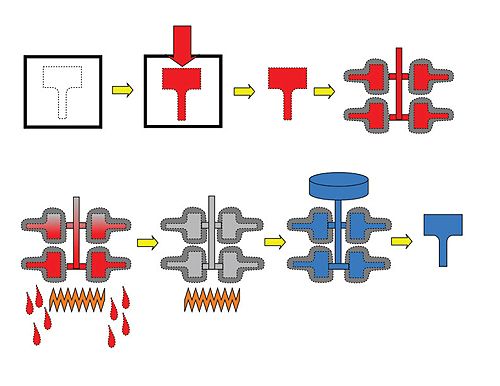
Figure 1: Investment casting begins with the mold that is CNC machined, using the part CAD. Special wax is injected into the mold cavity to form the part pattern. Multiple wax patterns are built up (wax welded) into a tree, using wax gates, runner, and a downsprue. The tree is “invested” with multiple coats of ceramic slurries to form a shell around the patterns. The wax is melted out of the shells and the shells are fired, leaving empty spaces into which is poured molten metal. After cooling, the shell is removed and the parts are cut from the tree.
When the molten metal freezes, what comes out of the shells are parts as complex as involutes, manifolds with curved internal passage, spirals, and unique structures such as turbocharger compressors or biomedical tools with projections or connecting struts, (Figure 2).
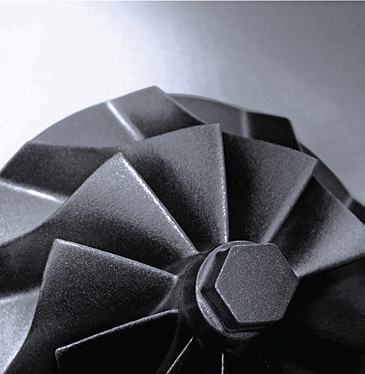
Figure 2: Precision of as-cast parts is unmatched by other conventional forming processes. Turbocharger compressors, cast from titanium are good examples. Although some are formed by machining, thin blades with a high degree of backangle are impossible to form with forging and uneconomical to form by CNC machining.
“Lean” manufacturing
From a manufacturing standpoint, the second most important aspect of investment casting is its efficiency. No near-net process is closer to the net. Most post forming operations are unnecessary. As parts are broken out of shells, often the only remaining task is cut them free of the gates, then sandblast or peen them to remove blemishes resulting from the melt process. As-cast finishes can be smooth, as fine as 60-90 μin. RMS. Some parts may require a slight straightening or heat-treating process, but secondary machining and joining are usually unnecessary since casting creates and integrates complex part geometries.
Investment casting is material efficient, generating far less waste than wrought processes. This becomes increasingly important when using costly alloys. Also, the process is accurate. Dimensional tolerances of ± 0.003 in./in. are readily achieved. This tolerance is critical on parts such as turbocharger compressor wheels that spin at speeds greater than 200,000 rpm and have to be finely balanced. Finally, delicate parts with walls as thin as 0.025 in. can be investment cast.
Nearly any metal that can be poured can be investment cast. However, because it is so material efficient, economics are particularly attractive for high performance alloys. High on the list is titanium with its superior strength-to-weight properties at high temperature and in corrosive environments. Zirconium is similar, and is often the choice for parts such as valve components in extremely corrosive applications. Other metals include cobalt-chrome alloys for biomedical implants, a number of stainless steel alloys, and nickel alloys where very high temperature creep resistance is needed as in aerospace applications.
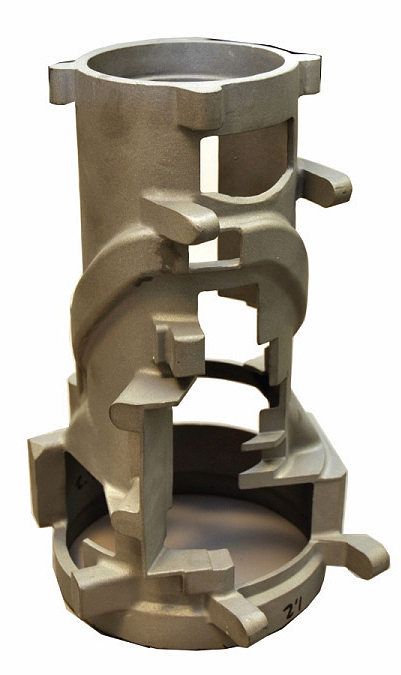
Shape complexity drives designers to choose investment casting as a forming process. This military gun housing weighs 2.9 lb and is cast in a single piece, using a custom titanium alloy.
The ideal investment cast part
Shape complexity will steer you toward investment casting; the more impossible a part is to machine, the more likely that it will be investment cast. For instance, manifolds with multiple internal passages that curve in different directions, valve bodies with intersecting holes and non-uniform passages, compressor airfoils, biomedical implants and custom surgical instruments, and complex firearms receivers would be impractical to form by machining.

Choice of forming process for this trunion could have been CNC machining (multiple steps), plus welding two sections together. However, considerable material would have been scrapped. Investment casting forms the trunion in essentially a single step.
Unlike other fabrication processes, shape complexity has virtually nothing to do with processing costs of investment cast parts. The primary expense lies in creating the tool. For instance, once the tool is built, a turbocharger impeller with its contoured blades is no more difficult to cast than a simple straight rod.
Shape guidelines
To get the best parts from investment casting, remember that it is essentially a flow process, (Figure 3). Keep junctions smooth, and avoid sharp corners with radii less than 0.030 in. Avoid sharp edges and allow at least 0.060 in. outside radii. Also avoid major transitions in section thickness as these tend to cause flow problems as the metal freezes. Space out the intersections where sections join, and for large flat areas use ribs and stiffeners to avoid warping.
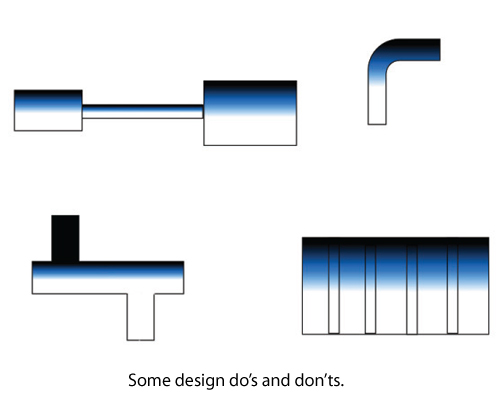
Figure 3: Investment casting is essentially a flow process. Keep junctions smooth. Avoid sharp corners. Avoid sharp edges. And avoid major transisions in section thickness.
Part evaluation
Investment casting lends itself to all state-of-the-art modern modeling and rapid-prototyping techniques. For a potential product, the designer provides 3-D model and a 2-D print that details specifications and tolerances. If the product has a complex shape with multiple changes in wall thickness, the caster will evaluate it using a numerical solidification model to analyze metal flow and potential shrinkage problems. The next step is to make a wax prototype of the part by stereolithography or 5-axis wax machining. Gate positions are set and a prototype shell is made from which the prototype is cast.
The prototype is captured with white-light scanning, digitized to create an electronic model, and compared to the original CAD design. The digital part model is modified if necessary to accommodate non-uniform shrinkage. At that point, parts are ready to be made.
Typical time elapsed in prototype development is 10-14 days.
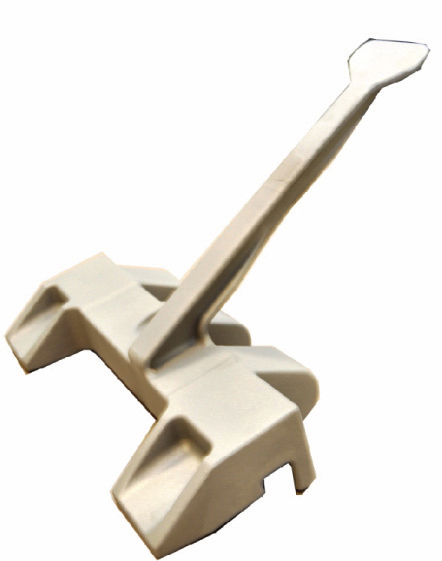
Combining two or more parts into a single unit is simple with investment casting. Instead of forming the body and handle of this latch and welding them together, they were designed as one piece.
How investment casting stacks up
The proverbial bottom line about investment casting is that designers make things with it that cannot be—economically—made any other way.
In addition to shape versatility, investment casting offers a number of economic advantages when compared to forging and machining, (Figure 4). For instance, the stock from which investment castings are made is ingot stock which is, at worst, 50% less expensive than wrought stock—and can be as much as an order of magnitude less. Also, in investment casting, runners, sprues, and gates that are cut off are all recycled. Little “chip waste” is left on the floor.

Figure 4: Relative costs of the three forming processes capable of forming complex shapes.
Like injection molding, you can sometimes use investment casting to combine multiple parts into a single unit, saving a number of manufacturing steps. Few other metal-forming processes have this capability.
Specifically, here’s how it compares to other common forming processes:
Forging produces the strongest metallic parts available because the hot working aligns the metal grain in a manner that increases strength and toughness. Investment castings typically cannot match the absolute strength of forgings. However, specialized technologies—such as selective solidification and grain refinement during solidification—have enabled casting processes to close the gap considerably. Now, finished parts are stronger than conventional as-cast parts. Also, careful design can add metal to strengthen critical areas, making investment castings almost as strong as forgings. In-process modification of alloy chemistries can increase strength, too—impossible with forging. Success of these strengthening techniques is demonstrated by the fact than today many commercial hammers—always forged in the past—are investment cast.
Machining is one of the fastest ways to produce metal parts, but at the same time produces considerable chip scrap—from expensive wrought stock. Complex parts that require multiple machining steps quickly rack up expensive machining time. Shape versatility of machining is obviously great, but not as great as that of investment casting.
Discuss this on The Engineering Exchange:
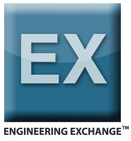
FS Precision Tech
http://fs-precision.com
Filed Under: Machine tools + subtractive manufacturing, Die casting

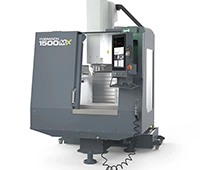
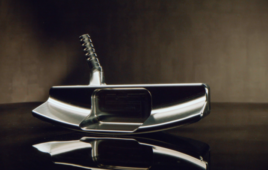
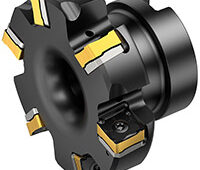
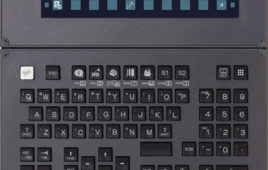
Hi,
can you cast zirconium? Zr702. I’m jewelry supplier from Finland and need that kind of service.